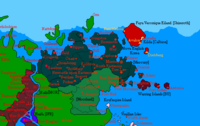Norse resettlement in Mercury: Difference between revisions
No edit summary |
m (→Background: Repetition of facilitate) |
||
| Line 22: | Line 22: | ||
==Background== | ==Background== | ||
Mercury and Normark had limited formal diplomatic relations prior to the treaties | Mercury and Normark had limited formal diplomatic relations prior to the treaties ratified to enable the construction of the [[Trans-Keltian Express]], which commenced in {{AN|1686}}. The opening of the railway in {{AN|1694}} saw the two nations introduce reciprocal free movement, with stipulations in place that this would not allow further free movement from Normark and the [[Raspur Pact]] into the rest of the [[Xäiville Convention]], and vice versa. In {{AN|1730}}, the two nations collaborated to extend the route into [[Aerla]] and [[Vegno]]. The extension was completed, slightly behind schedule, in {{AN|1733}} and remained in operation until the line's closure in {{AN|1737}}. | ||
==Mobilisation== | ==Mobilisation== | ||
Revision as of 09:44, 21 November 2024

|
This article or section is a work in progress. The information below may be incomplete, outdated, or subject to change. |
| Abbreviation | NoRiM |
|---|---|
| Formation | 1738 AN |
| Type | Humanitarian mission |
| Status | Active |
| Headquarters | Hayfield |
| Participating nations |
|
The Norse resettlement in Mercury, that took place in 1738 AN, was a humanitarian operation conducted by the government of Mercury in collaboration with the Raspur Pact and Operation Haven Shield. The operation, led by the Mercury Reserve Force, resulted in the resettlement of over 400,000 newly-stateless Norse diaspora in the western part of the country. Mercury also claimed the section of land directly between its western border and the northern entrance to the Strait of Haifa, as well as a small area on the western bank of the strait, creating a humanitarian corridor by which displaced citizens could move free of obstacles, utilising the existing infrastructure put in place to facilitate the operations of the Trans-Keltian Express. The Keltia Command of the Raspur Pact played a vital role by providing logistical support and humanitarian supplies through its existing infrastructure network, enabling Mercury to efficiently manage the crisis and support the newly-stateless Norse diaspora refugees.
Background
Mercury and Normark had limited formal diplomatic relations prior to the treaties ratified to enable the construction of the Trans-Keltian Express, which commenced in 1686 AN. The opening of the railway in 1694 AN saw the two nations introduce reciprocal free movement, with stipulations in place that this would not allow further free movement from Normark and the Raspur Pact into the rest of the Xäiville Convention, and vice versa. In 1730 AN, the two nations collaborated to extend the route into Aerla and Vegno. The extension was completed, slightly behind schedule, in 1733 AN and remained in operation until the line's closure in 1737 AN.
Mobilisation
Collaboration with Raspur Pact
Strait of Haifa claim
Aftermath
See also
- Norse diaspora
- East Keltian Collapse
- Operation Northern Light
- Operation Haven Shield
- Treaty of Hayfield
